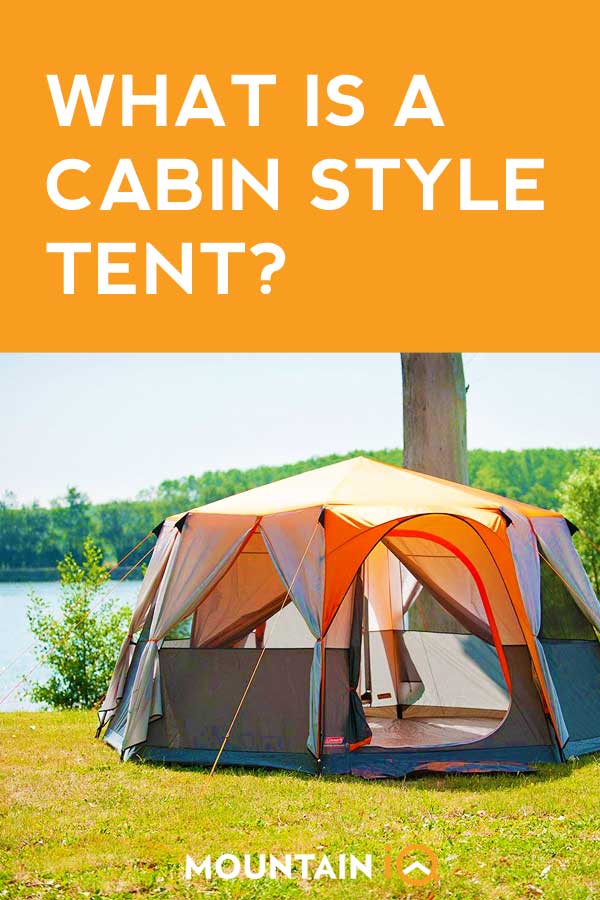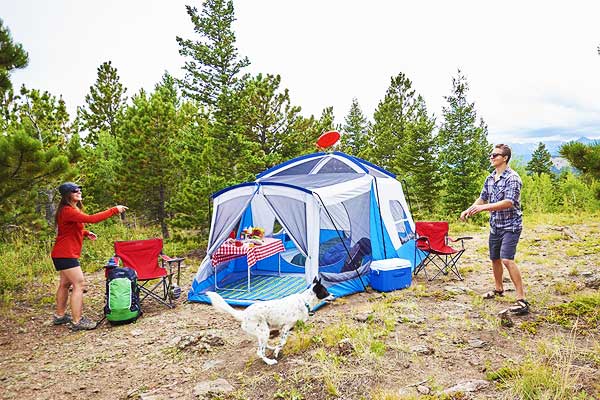When you want to camp but your partner wants a cabin, compromise by getting a cabin tent. Getting the right one to suite both your needs can be really tough.
If you are worried about space, check out the Wenzel Klondike. It sleeps 8 people inside the tent and has an outside convertible screen room for a storage or kitchen area.
The Eureka Copper Canyon LX is a beautiful 3 season tent that allows you to get outside come rain or shine.
When looking for a "lock up and go", or should I say "pop up and go" type of tent, what you want is the Coleman Instant 6 which sets up in only 60 seconds.
Best Cabin Tents (Top Picks)
Best Overall
Best Value
Best 2-Room
This article contains affiliate links. If you buy something through the links on this page, we might get a small commission. It will not affect your price but helps keep our site alive!
Top Cabin Tents For Camping (Detailed Reviews)
We reviewed over 13 cabin tents for this article. Below are the best cabin tents that made our short list.
- Core 9 Person Instant Cabin - Best Overall
- Wenzel Klondike 8
- Eureka Copper Canyon LX
- Coleman WeatherMaster - Best 2-Room
- Coleman Montana 8
- Standing Room Family Tent
- Core 4 & 6 Person Camp Tent - Fast Set Up
- Coleman Instant 6 - Best Value
Read our complete buyers guide for cabin tents.
1. Best Overall Cabin Tent
The Core 9 Person Instant Cabin is a well-designed and functional tent that offers an excellent option to all outdoor enthusiasts that want a large comfortable space. With a pre-assembled frame, most of the effort of setup has been taken away.
With its mesh roof and huge windows and doors, you can enjoy the outdoors in comfort with uninterrupted views. The design allows you to enjoy the space with windows open while maintaining privacy, but they can be closed with zip panels.
Main Features
What we like
What we dislike
2. Great Cabin Tent
The Wenzel Klondike 8 sleeper comes in at a close second in the Best Cabin Tent review. Well-priced, good looking and filled with great features including a screen room, it is an excellent addition to your family’s camping gear staples.
Main Features
What we like
What we dislike
3. Best 3 Season Tent
The Eureka Copper Canyon is a great looking, all rounder that is rated for three seasons. It comes up tops for space and comfort with a 10 x 10 ft. internal space, and a very generous center height of 7 ft.
While it is still quite heavy, it packs up into a convenient and compact package, making it easier to carry around.
Main Features
What we like
What we dislike
4. Best 2-Room Cabin Tent
The Coleman WeatherMaster is a two-room tent with an additional screen room, giving you exceptional space. Weighing in at 32 lbs. this is one of the heavier tents reviewed but given the size of the tent, this is to be expected.
Main Features
What we like
What we dislike
5. Best Large Cabin
The Coleman Montana 8-person tent is a hybrid between a traditional dome tent and a cabin tent. With the familiar crisscross tent pole structure, setup is about 15 minutes, which is a bit longer than other tents reviewed, but considering the size of this tent and all the additional features, it is well worth the effort.
Main Features
What we like
What we dislike
6. Second Home Cabin Tent
The Standing Room Tent is a hanging tent, and as such does not come with a frame. You need a separate 10 x 10 ft. canopy frame that you can attach this tent to. Clips are included.
This large cabin tent is sure to offer you the closest thing to the comforts of home. With an impressive 8.5 ft. center height, even the tallest person can stand up tall and in comfort.
Main Features
What we like
What we dislike
7. Fast Set Up Cabin
The Core 4 & 6 Person Camp Tent range has options for 6 to 12 people. The one reviewed here is the 6-sleeper with wall organizer.
Perfect for a small to medium sized family or group, this freestanding tent is great for summer and mild temperatures.
While the tent can sleep 6, it will be a tight squeeze, so for maximum comfort, stick to maximum 4 adults or 2 adults and 2 children.
Main Features
What we like
What we dislike
8. Best Value Cabin
A little bit smaller than some of the other cabin tents, the Coleman Instant 6 sleeper offers great value for money. Poles are pre-attached to allow for quicker setup with an integrated fly.
While this tent does feature Coleman’s WeatherTec system, some users have reported leaks in heavy rain, so best keep this freestanding tent for dry weather camping trips.
Main Features
What we like
What we dislike
Buyer's Guide
What is a Cabin Style Tent?
Unlike dome or long tunnel tent, cabin tent offers a comfort of almost straight walls and practical space use. This is great for joint camping, as you will be able to stand up and move around the tent easily.
Although on a heavier side and made of nylon or canvas, cabin tents most resemble home outdoors and are perfect for long car camping with more people. However, they are not suitable for hiking or backpacking.
All the above tents have good space in terms of living area, and height clearance. What sets them apart is additional communal space, like a screen room, or a split two-room configuration.
Consider how much time you are prepared to spend setting up. Some tents are easy to do on your own, while others can be part of the adventure, and you can set up as a group, or with your children. Then 20-30 minutes is not such a deal breaker.
It’s a good idea to prep your tent before you head out. Make sure you use a seam sealant or seam tape if you’re heading into wet conditions. This will ensure that any needle holes created during the manufacturing process are well closed.
The main things to consider when buying a cabin tent:
- Number of people
- General Use
- Weather
- Budget
What is the Easiest Tent to Put Up?
Among cabin tents the easiest one to set up are Core 4 & 6 Person Camp Tent, Core 9 Person Instant Cabin and Coleman Instant Tent 6.
You don’t want to spend most of your holiday fighting with your tent. While a manufacturer might proclaim a quick setup – even as little as 60 seconds, you will still need to practice a few times before you become proficient. Practice setting up and taking down the tent a number of times before you start your trip, especially if you’ll be doing it on your own.
For the fastest and easiest set up check our suggestion for Pop Up Tents.
Other Features to Consider Before Getting a Cabin Tent
Weight & Packed Size
A cabin tent is traditionally bigger and heavier than a dome tent, so if you’re looking for a backpacking option, a cabin tent might not be your best bet. On average a 6-person tent will weigh around 24 lbs. If you are okay with the weight, look for a compact package that is not too cumbersome to carry. Some tents include a pack that can be carried as a backpack, keeping your hands free to carry other things.
Materials: Fabric & Poles
All tents will use a fabric that is treated for various degrees of waterproofing. Some may be treated to resist stains and be strengthened for abrasion resistance, offering additional durability.
Poles are generally steel or fiberglass as these materials give a good balance between strength and weight.
Floor Space & Height
While manufacturers may rate their tents for a specific number of people, this guideline is really for maximum sleeping area, which does not take into account additional space for gear, chairs or tables, or just space to get dressed and move around. For comfort, opt for a tent with capacity more than the expected number of campers.
Weather Resistance & Season Rating (Single vs Double Wall)
Most general use tents will be rated as 3-season so it will withstand light rain and wind. Things like mesh roofs and windows will provide better ventilation but can be cold when the sun sets, even with a fly attached. A separate rainfly will keep condensation and light rain out, but check if the fly is adjustable or fixed, and how much overlap there is over windows and doors to prevent leaks.
Look for a sturdy frame with options for guy lines for improved stability to withstand wind.
Comfort
Factors that will add to comfort include space, and temperature. You’ll want sufficient space to not feel cramped as well as good ventilation from vents and windows. Some tents feature blackout technology that reduces the amount of sun that gets in, thereby reducing the internal temperature by up to 10%.
Footprints
If the floor of the tent is not very durable or well sealed against moisture, you may need an additional footprint. This is cumbersome as it’s additional gear to pack. However, if you are sleeping on a cot rather than directly on the floor, you may be able to do without an additional footprint.
Accessories
It’s always useful to have a range of accessories that you can purchase to improve or upgrade your purchase. Some manufacturers include additional footprints or screen rooms that can be attached, or extra tent poles. Being able to buy specific replacement parts that get broken or lost, rather than replacing the entire tent is also a pro.
Continue browsing
See more outdoor gear reviews and our detailed camping tent guide. Or check out these reviews:










